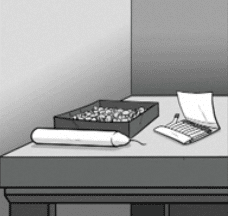The Blog Library
Business & Creativity | How To Solve Your Candle Problems
Have you ever tried to solve the Candle Problem? It’s a classic. Imagine you’re given a box of tacks, matches, and a candle.
Your goal? To attach a burning candle to the wall.
How would you do it?
The candle problem has a simple solution (click here if you want to see it, thanks to Dan Pink via Marilyn Burgess for the image above). But the candle problem is not so simple to actually solve.
The candle problem was designed in the 1940s to illustrate an interesting psychological hangup called ‘functional fixedness.’ Which means – we tend to see items in terms of their obvious purposes: The candle for burning, matches for lighting, tacks for tacking. But we habitually overlook creative, alternative uses of the items.
Can you immediately think of the box as a platform and not just the container you’re given tacks in?
Here’s the kicker: If you offer people an incentive (like money) for solving the problem quickly, they get even worse at it, and it takes longer for them to solve the problem.
Incentives do help us work faster when the ‘correct’ answer is obvious. If you just said “hey, stick these tacks in the wall,” people with an incentive will perform brilliantly. But when the problem requires creative thinking, when the answer is not obvious, incentives make things worse. You’ll be trying so hard to get it done that you can’t think creatively.
 Every facet of the photography business is essentially a candle problem. And the answers are never obvious.
Every facet of the photography business is essentially a candle problem. And the answers are never obvious.
The work of photography requires us to see and capture the world differently, to have a vision of what can be created rather than what is. The business and marketing side requires us to differentiate ourselves from everyone else out there – a tall order when it feels like everything has already been done.
How can we solve our candle problems?
Can we slow down, step back, put the phone down, and just look at what’s in front of us for a little while?
Instead of galloping through our sessions and catching the obvious shots, can we reject the pressure to constantly be pressing the shutter button and really look around us?
Can we be brave enough to say to a client “Well, this might not work, but why don’t we try…..”? Can we handle a little silence during the sessions while we let our mind and heart breathe?
Can we create personal projects where we aren’t motivated by the money and just let our creative mind have its unhurried moment in the sun?
Can we take inventory of every single asset we have (just as the candle problem requires us to see not just the tacks, but the tack box) and look inward for solutions? The fastest way to get more is just to see new uses for the stuff you already have.
There’s nothing about being a photographer that says you have to have a website, a ProPhoto blog, or a set of Moo business cards. Those are tools, yes, and important ones – but are you using them because they serve your creative purposes and business needs? Or are you using them because they are what the photographer down the street uses? Are they the obvious solutions you grabbed while trying to make money? Or did they come into play as you schemed a master plan for getting your business and vision off the ground?
If you find yourself banging your head against the wall about something – you’re probably dealing with a candle problem. And the solution lies in stepping back, slowing down, thinking creatively, and using everything you’ve got, in whatever ways you can, no matter what people say you should be doing.
* Candle Problem Image Source: Dan Pink via Marilyn Burgess. The Candle Problem was developed by Karl Duncker.






Brilliant!!!
Thanks for the kind comment! 🙂
Well said. 🙂
Ditto on the brilliant!
Great advice. Thanks for sharing!